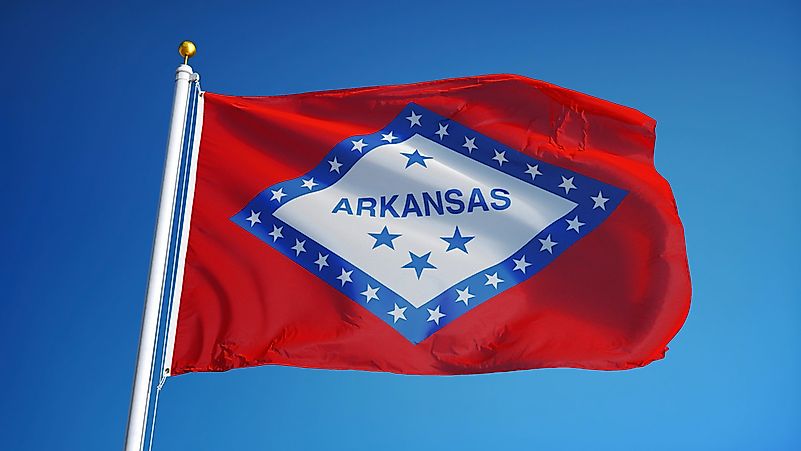
Registration Form Reunion Hotel Information
Little Rock Ar. - 2024
Reunion Tour Schedule
Sunday, September 29: Early bird arrival. Hospitality room opens at 1: PM.
Monday, September 30: Arrival, check in and get reacquainted with shipmates. Hospitality room opens at 10:00 AM.
Tuesday, October 1: $48, 9:30 AM Departure.
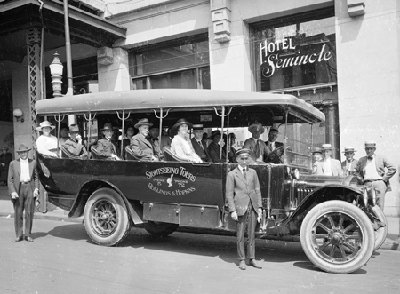 At 9:30 AM our luxurious air conditioned motor coach departs our hotel to whisk us to the Arkansas Inland Maritime Museum. Arkansas Inland Maritime Museum (AIMM) is home to the USS Razorback (SS 394) and USS Hoga (YT 146) and is located in North Little Rock Riverfront Park along the shore of the Arkansas River. The USS Razorback, a World War II Submarine, was built in September 1943 and commissioned on April 3, 1944. She is the longest-serving combat front-line submarine existing in the world today, and has been commissioned by two different countries for 56 years of active duty. The USS Razorback made her official homecoming to North Little Rock, Arkansas in June 2004. Since May 2005, she has been open to the public for tours and seen many people throughout her years.
At 9:30 AM our luxurious air conditioned motor coach departs our hotel to whisk us to the Arkansas Inland Maritime Museum. Arkansas Inland Maritime Museum (AIMM) is home to the USS Razorback (SS 394) and USS Hoga (YT 146) and is located in North Little Rock Riverfront Park along the shore of the Arkansas River. The USS Razorback, a World War II Submarine, was built in September 1943 and commissioned on April 3, 1944. She is the longest-serving combat front-line submarine existing in the world today, and has been commissioned by two different countries for 56 years of active duty. The USS Razorback made her official homecoming to North Little Rock, Arkansas in June 2004. Since May 2005, she has been open to the public for tours and seen many people throughout her years. On 11 May 1962, Razorback participated in the “SWORDFISH” nuclear weapons test. An ASROC with a nuclear depth charge warhead was fired by the destroyer Agerholmn (DD 826) at a target raft from a range of 2 nautical miles. Razorback was submerged at periscope depth 2 nautical miles from the target raft. The ASROC weapon produced a powerful underwater shock wave which visibly shook Razorback and her crew. The resulting data was used to formulate tactical doctrine for ASROC, a weapon that remained in front-line service for nearly 30 years.
On 11 May 1962, Razorback participated in the “SWORDFISH” nuclear weapons test. An ASROC with a nuclear depth charge warhead was fired by the destroyer Agerholmn (DD 826) at a target raft from a range of 2 nautical miles. Razorback was submerged at periscope depth 2 nautical miles from the target raft. The ASROC weapon produced a powerful underwater shock wave which visibly shook Razorback and her crew. The resulting data was used to formulate tactical doctrine for ASROC, a weapon that remained in front-line service for nearly 30 years.
On 30 November 1970, USS Razorback was decommissioned and transferred to the Turkish Navy. She was recommissioned as TCG Muratreis (S 336) on 17 December 1971. Muratreis served in the 1st Submarine Squadron, based in Karadeniz Eregil on the Black Sea. On 13 August 1993, she was transferred to the 2nd Submarine Squadron, sailing out of Gölcük and Karadeniz Eregil.
During her service with the Turkish Navy, Muratreis served as a front-line, combatant submarine, making at least 14 patrol rotations and 7 long-range deployments. She also participated in the NATO-sponsored exercise LINKED SEA-95, conducted in the Atlantic in June 1995.
TCG Muratreis was decommissioned on 08 August, 2001. On 25 March 2004, the Turkish Navy officially transferred Muratreis to the “USS Razorback / TCG Muratreis Association”, which is now the Arkansas Inland Maritime Museum Foundation.
A barbecue lunch is included in the cost of the tour and will be served around 12:30 PM.
Navy yard tug Hoga (YT 146) was a hero and a survivor at Pearl Harbor. Hoga was moored with other yard service craft near the drydocks at 1010 Dock when Pearl Harbor was attacked by Japanese forces on the morning of 7 December 1941. Hoga ran to the assistance of the minelayer USS Oglala, flagship of Rear Admiral William Rea Furlong, commanding Minecraft, Battle Force. As she reached Oglala at 8:50, Hoga was passed by the battleship USS Nevada, then making a run for the open sea. Just as the second wave of planes struck, the damaged Nevada got underway at 8:45, her officers hoping to escape the trap and run for the open sea through the narrow harbor entrance. The Japanese "recognized a golden double opportunity to sink a battleship and at the same time bottle up Pearl Harbor."[4] The planes concentrated their attack on Nevada, which continued running, bombs crashing around her and on her forward deck and superstructure. At 9:07, a second "hail of bombs" rained on the ship, one striking the forecastle. By 9:10, Nevada was sinking, and she was grounded on Hospital Point to avoid going down in the channel. 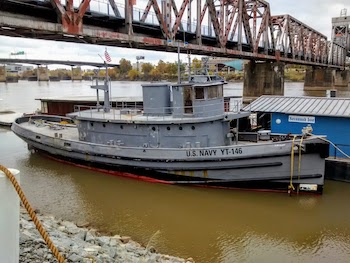
Meanwhile, Hoga, with another vessel, was assisting Oglala. Damaged by the detonation of a torpedo against the cruiser USS Helena, moored next to Oglala, the listing minesweeper required towing to clear the field of fire for Helena. As the sinking Oglala was moved aft of Helena by Hoga, "Admiral Furlong saw the Nevada 'give quite a heave,' and reflected to himself 'Well...there she is in the channel and there is going to be trouble if that ship sinks in the channel.' So he sent the two tugs that had been assisting Oglala to help nose the Nevada over toward Hospital Point.
Hoga then worked with the other tug, YT-130, to pull the battleship free and move her to the western side of the harbor entrance, where by 10:45 she settled as Hoga poured water onto the burning deck and into the virtually destroyed forward section.[6] Tied to the port bow, Hoga worked on a raging forecastle fire with the pilothouse monitor and four hose lines for over an hour before retiring.
From Nevada, Hoga returned to Battleship Row, fighting fires on USS Maryland, USS Tennessee, and finally Arizona. Hoga worked the Arizona fire from 16:00 hours on Sunday until 13:00 hours on Tuesday, 9 December. Following 72 continuous hours of firefighting, Hoga remained on active duty through the rest of the week, patrolling the harbor, assisting in body removal, and searching for Japanese submarines believed to be hiding in the harbor.[7][unreliable source?] The actions of the tug's skipper and crew did not go unrecognized. In February 1942,[clarification needed] Admiral Chester Nimitz, CINCPAC, commended McManus, his men, and their tug for a job well done.
Wednesday, October 2 $18, 9:30 AM Departure.
 We're off to the Arkansas Museum of Fine Arts
We're off to the Arkansas Museum of Fine Arts The Arkansas Museum of Fine Arts Foundation Collection is the Museum’s permanent collection of two- and three-dimensional art. This international collection boasts over 14,000 works and spans eight centuries, with strengths in works on paper and contemporary craft, and includes notable holdings by artists from Arkansas, the American South region, and across the United States.
The Arkansas Museum of Fine Arts Foundation Collection is the Museum’s permanent collection of two- and three-dimensional art. This international collection boasts over 14,000 works and spans eight centuries, with strengths in works on paper and contemporary craft, and includes notable holdings by artists from Arkansas, the American South region, and across the United States.
The Anne Lindberg passage is a luminous cloud of color floats above Museum visitors, creating an unexpected art experience as they walk through the galleries. This exhibition is a newly commissioned work by Anne Lindberg, an artist based in upstate New York. The piece begins as a whisper and gains mass as time goes on,” she explains. “It’s performative.” Although her installations are volumetric, Lindberg considers them to be drawings—they create lines in space. One wall will feature a large vertical drawing on mat board with dozens of brightly colored, thin, horizontal lines created by the artist with the help of a parallel bar. The drawing, grene, has been acquired for the AMFA Foundation Collection.
The artist designed this installation specifically for the narrow corridor gallery. Lindberg notes, “passage is a narrow-compressed form that floats overhead and is located within a slender pinch point between large exhibition spaces in the Museum. The overall form shifts direction mid-way along its horizontal length to create a gap or pause, a peek through its vertical depth.” The work is also unusual in that visitors will walk below it, creating an immersive experience.
Lunch is available (on your own) at the Park Grill on the museum grounds.
After lunch we will tour The McArthur Arkansas Military Museum. Shortly after Arkansas was admitted to the Union in 1836, the federal government established the Little Rock Arsenal for the storage of munitions and weapons in defense of the frontier. Eventually, more than thirty buildings were constructed on this 36-acre site, including an armory, officers' quarters, barracks for enlisted men, and a variety of other buildings necessary for the routine operation of a military post.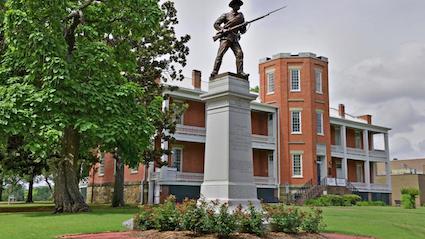 After Arkansas seceded in May 1861, Confederate forces used the arsenal until September 11, 1863, when Union troops commanded by General Frederick Steele captured Little Rock. Renamed the Little Rock Barracks in 1873, the post was used to garrison troops until it closed in 1890.
After Arkansas seceded in May 1861, Confederate forces used the arsenal until September 11, 1863, when Union troops commanded by General Frederick Steele captured Little Rock. Renamed the Little Rock Barracks in 1873, the post was used to garrison troops until it closed in 1890.
Constructed in 1840, the Tower Building is the only surviving remnant of the Little Rock Arsenal and one of central Arkansas's oldest structures. With exterior walls almost three feet thick, the massive edifice originally served as a munitions warehouse. 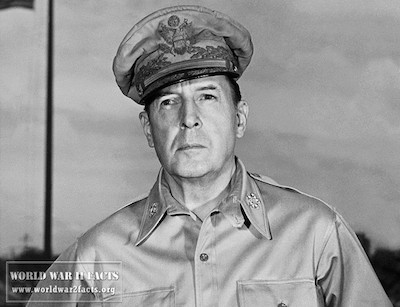 After the Civil War, the building became quarters for Arsenal officers and their families. In January 1880, Douglas MacArthur, future General of the Army, was born here while his father, Captain Arthur MacArthur, was stationed in Little Rock.
After the Civil War, the building became quarters for Arsenal officers and their families. In January 1880, Douglas MacArthur, future General of the Army, was born here while his father, Captain Arthur MacArthur, was stationed in Little Rock.
For the next fifty years, the Tower Building remained largely vacant and deteriorating. Finally, in the late 1930s, the structure underwent renovation and opened in 1942 as the Museum of Natural History and Antiquities, which occupied the building until 1997.
After another, more comprehensive renovation, the historic structure opened in May 2001 as the MacArthur Museum of Arkansas Military History. Built for protection on a perilous frontier, this National Historic Landmark survived the Civil War, witnessed the birth of a military legend, and now returns to its origins as an educational facility interpreting our state's rich military heritage.
5.) Thursday, October 3rd 9:00 AM Business meeting for all shipmates. 9:00 AM Ladies Trivia
5:30 PM Banquet tonight - $58 per person
Return to Hotel Page Registration Form




 Commanding Officers
Commanding Officers Small Stores
Small Stores